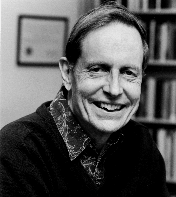Paul Garabedian

Paul Roesel Garabedian (Armenian: Փոլ Գարաբեդյան, August 2, 1927, Cincinnati – May 13, 2010, Manhattan) was a mathematician and numerical analyst.[1] Garabedian was the Director-Division of Computational Fluid Dynamics at the Courant Institute of Mathematical Sciences, New York University.[2] He is known for his contributions to the fields of computational fluid dynamics and plasma physics, which ranged from elegant existence proofs for Potential theory and conformal mappings[3] to the design and optimization of stellarators.[4] Garabedian was elected a member of the National Academy of Sciences in 1975.[5]
Education and career
Born in Cincinnati, Ohio, Garabedian received a bachelor's degree from Brown University in 1946 and a master's degree from the Harvard University in 1947, both in mathematics. He received his Ph.D., also from Harvard University, in 1948 under the direction of Lars Ahlfors.[6] It was at Brown University that he met his longtime colleague and collaborator, Frances Bauer.[7]
In 1949 Garabedian joined the faculty at the University of California as an Assistant Professor and became Associate Professor in 1952. In 1956, he moved to Stanford University as a Professor of mathematics. In 1959 he moved to the Institute of Mathematical Sciences [later renamed the Courant Institute] at New York University. In 1978 he was appointed the Director-Division of Computational Fluid Dynamics at the Courant Institute of Mathematical Sciences, New York University. In a long and fruitful academic career, Garabedian supervised 27 Ph.D. theses. The first was in 1953 (Edward McLeod) and the last came in 1997 (Connie Chen).
Honors and awards
- Sloan Fellowship, 1961–63
- Guggenheim Fellowship, 1966[8]
- Fairchild Distinguished Scholar Caltech, 1975
- NASA Public Service Group Achievement Award by NASA Langley Research Center, 1976
- Boris Pregel Award, New York Academy of Sciences, 1980
- Birkhoff Prize of the AMS and SIAM, 1983[9]
- Theodore von Kármán Prize, SIAM, 1989
Books
- Partial Differential Equations, 2nd ed., Chelsea Pub. Co. (1998). ISBN 0-8218-1377-3
- Magnetohydrodynamic Equilibrium and Stability of Stellarators, with F. Bauer and O. Betancourt. Springer-Verlag (1984). ISBN 0-387-90966-4
- Supercritical Wing Sections II, with F. Bauer, D. Korn and A. Jameson. Lecture Notes in Economics and Mathematical Systems, Springer-Verlag (1975), ISBN 0-387-07029-X.[10]
References
- ↑ "NYU > Courant Institute > Announcements". cims.nyu.edu. Archived from the original on 2010-06-03. Retrieved 2010-05-19.
- ↑ Paul Garabedian at Courant Institute of Mathematical Sciences
- ↑ Garabedian, P. R.; Schiffer, M. (1950). "On existence theorems of potential theory and conformal mapping". Annals of Mathematics. 52 (1): 164–187. doi:10.2307/1969517. JSTOR 1969517.
- ↑ "Archive (1995-present)". American Physical Society. Retrieved 2009-04-29.
- ↑ "National Academy of Sciences". National Academy of Sciences. Retrieved 2009-10-31.
- ↑ "In Memory Of ..." American Mathematical Society. Retrieved 26 June 2010.
- ↑ Interview with Paul Garabedian
- ↑ Paul Roesel Garabedian - John Simon Guggenheim Memorial Foundation Archived 2011-06-03 at the Wayback Machine.
- ↑ "George David Birkhoff Prize in Applied Mathematics". American Mathematical Society. Retrieved 2009-11-02.
- ↑ Abstract of Supercritical Wing Sections II
External links
- Garabedian's Curriculum Vitae
- Paul Garabedian at the Mathematics Genealogy Project
- New York Times obituary